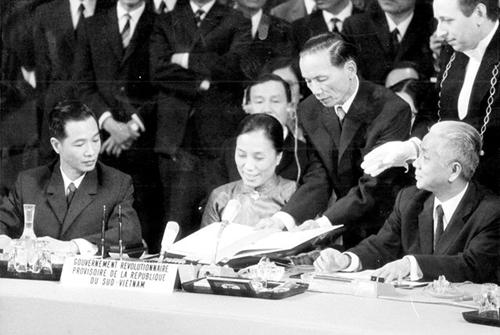The Paris negotiations were long and fierce. The conference and the signing of the Paris Peace Accords came from the result of our struggles on the battlefield and through negotiations, demonstrating the method of war settlement of both Vietnam and the U.S. in the specific conditions of each country and along with the international situation at that time.
The Paris Peace Accords, which put an end to the war and restored peace in Vietnam, was signed on January 27, 1973 in Paris (France). The document compelled the United States to withdraw all forces from South Vietnam and recognize Vietnam’s independence, sovereignty, unification, and territorial integrity.
    |
 |
|
Foreign Minister Nguyen Thi Binh representing the Provisional Revolutionary Government of the Republic of South Vietnam to sign the Agreement on Ending War and Restoring Peace to Vietnam in Paris |
The U.S. had a lot of experience in international issues with skilled diplomats. It had quite clear negotiation strategy: to engage in negotiations while advancing military tactics in Vietnam. Meanwhile, Vietnamese diplomacy service was still in its early days then. After the Dien Bien Phu Victory in 1954, Vietnam had no imprints in diplomacy. Therefore, Vietnamese diplomats were sent to Paris to learn more experience in response to the U.S. diplomatic strength.
From 1968 to 1973, the Paris negotiations went through 201 public sessions, 45 high-level private meetings, 500 press conferences, and 1,000 interviews, with thousands of anti-war and pro-Vietnam marches. Vietnam persistently requested the U.S. to end the war and withdraw all its troops without any conditions. For its part, the U.S. demanded that both sides withdraw their troops and restore the demilitarized zone to cut off support from the North to the South.
The U.S. side emphasized the slogan “both sides stop the war,” but for four years, they did not achieve any results. The Vietnamese side did not use that slogan, but focused on the difficult situations facing the U.S. and requested them to end the war.
In 1967, Hanoi forced the U.S. to stop bombing the North in preparation for negotiations. After the Mau Than General Offensive and Uprising, the U.S. reduced bombardment in the North (March 31, 1968). A negotiation conference was organized in October 1968, and the U.S. was requested to stop bombing North Vietnam. Since 1969, Vietnam had entered a period of both fighting and consolidating forces. The U.S. started the strategy of “Vietnamization of the war.” The diplomatic frontline at this time had the main task of pushing the enemy down one step on the battlefield, forcing the U.S. to unilaterally withdraw part of troops from Vietnam.
After Vietnam’s three years of struggle, the U.S. side agreed to unilaterally withdraw over 400,000 troops, creating a new advantage for the Vietnamese troops. During negotiations, the U.S. requested both sides to withdraw troops. But in autumn 1971, in the peace proposal of November 10, 1971, the U.S. had to accept Vietnam’s request. The move, in line with the victory of the 1972 spring–summer offensive, created a chance for Vietnam to implement negotiations from July 1972.
In August 1972, the U.S. and its Saigon puppet government postponed indefinitely the meetings at the Paris Conference. However, the U.S. and the Democratic Republic of Vietnam still had secret meetings. In October 1972, both sides completed “Draft Accords on Ending the War” and “Draft Accords on the Right of Self-Determination of the People of the South.” At the Paris Conference, on the basis of upholding principles, we were flexible in strategy and proactively made new proposals. President Nixon and Prime Minister Pham Van Dong exchanged notes and agreed to contents of the accords, and decided to send Kissinger to Hanoi and initialize the accords from October 24 to 31, 1972.
However, on October 25, 1972, the U.S. cheated and did not sign the documents as scheduled. Nixon sent a letter requesting the two sides to have another private meeting to discuss some more issues and postpone Kissinger’s trip to Hanoi. On October 26, 1972, Vietnamese government announced the documents and forced the U.S. to sign the accords according to the set time. The U.S. people and international public increased pressure on the Nixon administration.
From November 20, 1972 to December 13, 1972, Vietnam and the U.S. continued meeting to finalize documents. However, the Nixon administration once again duped and postponed the signing of the accords to pass his election and proposed to amend basic contents of the draft accords. Moreover, the enemy also carried out a strategic raid using air force to attack Hanoi, Hai Phong and other Northern provinces in late 1972.
The brutality of the U.S. was strongly condemned by the public. The Vietnamese people in the North bravely shot down many B-52 bombers and U.S. tactical aircraft, leading to the victory of the “Hanoi - Dien Bien Phu in the air” and defeat all U.S. plots.
In accordance with negotiating, Vietnam also made clear about the legitimacy of the Vietnamese resistance war in Vietnam and the peaceful goodwill of the Vietnamese people while exposing the plots of the U.S. during its aggressive war, contributing to creating the world people’s movement against the U.S. After failure in many fields, the U.S. was forced to sign the Paris Peace Accords and end the war in Vietnam.
As the Paris Peace Accords was signed, the Vietnamese resistance war against the U.S. gained glorious victory, marking a remarkable revolutionary period, contributing to national liberation and unification.
Translated by Minh Anh